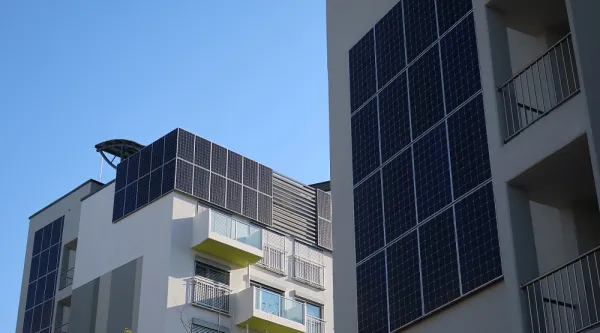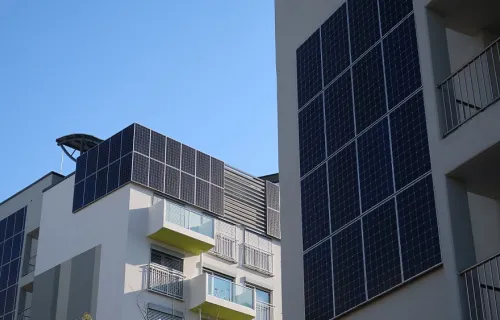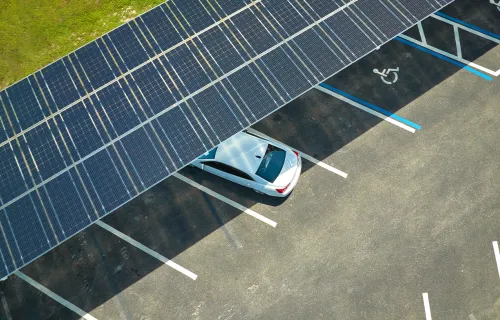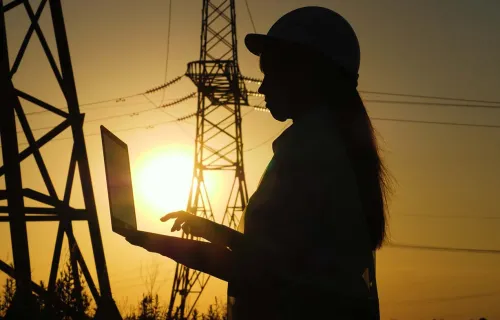- 1: Introductions
-
Matt Marrow:
Hello, and welcome to our Energy Transition Talks podcast. My name's Matt Marrow, I'm the director of digital transformation, working within our CGI U.S. utilities group. I've been with CGI for about 27 years, working in the utilities space for about seven. And we're here today to talk about DERMS, and I'd like to welcome my colleague Vincent, who's going to be talking with me today. So, Vincent, why don't you introduce yourself?
Vincent Dufresne:
Hello Matt. Hello everyone. My name is Vincent Dufresne, I'm a director at CGI, and I've been working in the utilities space for the past 18 years, all across North America. And I've worked mostly many topic areas around the energy transition. I've worked on energy efficiency, distributed energy resources (DERs), but also electrification, decarbonization and demand response, which is an interesting DER on its own.
- 2: Overview of DER types and the role of DERMS
-
Marrow:
Okay, thanks, Vincent. So, as I say, we're going to be talking about DERMS. I think everybody knows DERMS is a distributed energy resource management system. But I think to level set here, I think it'll be interesting to start with some of your definitions of the terms, Vincent.
Dufresne:
I think that the name says it, right? It's a piece of software that it's going to be used by utilities and other businesses. I'm thinking demand response aggregators, which are increasingly becoming distributed energy resource aggregators, DSM implementation contractors. But all of those businesses are using those systems to the benefit of utilities, to the benefit of the grids, and then ultimately to the benefit of their clients, of their clients, of their customers.
So, let me drill down a little bit about what distributed energy resources are, DERs, essentially. Well, the quintessential one is solar PV (photovoltaic)—those solar panels you see on the rooftop of buildings and in homes. These are energy resources that are located often behind the meters, so inside the buildings, but mostly they're located on the distribution system. And that's the novelty with those energy resources. They're connected on to the distribution system, they're not like your traditional nuclear and coal and the natural gas-fired power plants. They're connected much closer to the demand.
But I think what's often forgotten is, in very critical DERs, is the demand response. Demand response has been around for way more than a decade now. It's the ability of controlling equipment, turning them off, throttling them down. I'm thinking about air conditioning, I'm thinking about electric water heaters, pool pumps. So, the ability of controlling those resources, make those resources energy resources that utilities can tap.
And then finally, the newcomer is battery storage, whose cost is going down quite fast, and an increasing numbers of customers want them as a backup solution during outages. So, DER really encompass all of those resources. All of them connected on the distribution systems. And they're very important for the future and the energy transition and decarbonization. They don't emit carbon, and they're solving sort of a conundrum that the utilities system is increasingly suffering from. And that's the increase of the penetration of those new variable renewables connected on the transmission system.
So, wind farms, solar PV farms—those that are large, lots of panels on big piece of lands and connected to the transmission systems, they create variability in the supply. And so, the utilities, the distributors, they have to react by making their demand more flexible. And to do that, well, they can use solar panels on your rooftop, on other rooftop of buildings, they can use batteries, they can use demand response. So, all of these DERs are a solution to the increasing growth of the penetration of our clean variable renewables, which have become very cheap. And then they've been adopted, and their penetration keeps on growing.
Among other things, these are the benefits of the DERs. Now, there's good DERs, and there's bad DERs, I like to say. So those solar PV panels that are adopted, I'll say willy-nilly, we don't know where, by anyone. They're being adopted by customers, ultimately. So, utilities don't necessarily have control where those resources are being located. Well, those can create issues on the network.
Now add a management system, and from a resource that creates challenges, you turn it into a good DER where the resource all of a sudden generates value, not only for the customer who installed it but also for other customers and the utility itself. So that's what a DERMS does, ultimately. It enables utilities to control all of those resources and make them more valuable to everyone, and to contribute to the energy transition.
- 3: Right-sizing the grid for a decarbonized future
-
Marrow:
Okay. So, if DERMS turns bad DERs into good DERs, which is a benefit for everybody, I feel like we've been talking about this for quite a while. So, the amount of conversations we're having about DERMS seems to be increasing. So, why do you think that is happening right now?
Dufresne:
We're starting to see what the challenge that lies ahead really is. And it is a challenge that's made, of course, replacing the generation infrastructure that we have, the power plants, those that emit a lot of greenhouse gases, to either large solar farms or large wind farms and smaller solar PV panels and buildings and such. So that decarbonizes the current grid.
But, what we're seeing is that we also need to decarbonize the future grid. And the future grid is when the grid is going to have a lot more electricity demand because we'll have electrified a lot of energy usage, and we'll have much growth in demand too. We're not trying to decarbonize just the current grid; we're trying to decarbonize the future grid to when it'll have grown considerably. And in order to grow the grid and serve more demand, we're going to need to augment the hardware, the wires, the transmission lines, the transformer stations.
And that hardware is massively expensive, and that will require so much funding that ultimately, it'll put pressure on rates, and electricity prices could increase because of that situation, because of the energy transition. Well, that software, the DERMS, and all of the DERs that the software is going to control is a solution that will allow us to “right-size” the grid, to not overbuild that grid. When we do that jump ahead and build up the grid for the decarbonized future, we need to make sure that when we put assets, not only do we fully utilize the asset we currently have, but when we add assets, those will quickly become fully utilized.
So, the DERs and DERMS are really about right-sizing the grid, software being cheaper usually than hardware, so that we don't pay too much for our electricity looking ahead and as the economy gets decarbonized.
Now, of course, there's the big trend about distributed generation I mentioned—solar PV on rooftops, on buildings. And those may go viral. We've seen an increased penetration, an increasing number of customers have them on their buildings. We see that there's new federal funding for it. Many states have multiple layers of different schemes of incentives to encourage people to put them on their roof. In many states, I'm thinking California; I'm thinking New York, I'm thinking Hawaii. The penetration has increased so much that we start seeing impact on the distribution network and on the wholesale network as well.
And so, we're fearing that inflection point in technology adoption when the adoption takes off and all of a sudden everybody has them on their rooftop. So, there is this aspect that we need the DERMS now because maybe it's going to take off and go viral. Now, will it go viral or not? That's uncertain.
But here's another aspect that's coming up. Electrification is another factor, especially of transportation. That is already happening. People buy EVs (electric vehicles)—an increasing number of people buy them. So that's just another layer. And those that EV charging will also required to be managed. And then EV charging on its own will become a distributed energy resource. If it gets managed, or if the battery of your car gets to supply your house or your building, or if the battery of your vehicle gets to supply directly to the grid, that's named "vehicle to grid," right. So that's going to become a DER too.
So, the combination of the two trends is increasing the importance of being prepared. And acquiring a DERMS for utilities is one of the aspect that the utility will need to think about, in order to be prepared for that energy transition.
- 4: The need for enterprise DERMS
-
Marrow:
Okay. Seems to me, I've been hearing over the years there's been various solutions out there that can control devices on the grid. So, is there different types of DERs out there that we, is there a new type of DER we're looking for? Can you give me some examples?
Dufresne:
No, I think there's been DERMS for a while now. Like I mentioned, the demand response is a demand-side management practice that, along with energy efficiency, that has been around for well more than a decade now. And it's basically the ability of shutting, turning off certain equipment during peak time. And then those programs are increasingly becoming more sophisticated with more ability to more granular sequence of on and off, and the ability of reducing the impact on customers of those on and off.
I mean, we already had an ecosystem of demand response management system, which quite naturally evolved to become distributed energy resource management system, because essentially, those pieces of software were already deployed to control behind-the-meter devices. And so, those smart inverter, for example, that inverter, that is the key central piece of your PV system, well, it's only a small stretch to use those formally named DRMS systems, to turn them into DERMS system.
And so, there is a plethora of those systems used by those businesses I mentioned just a while back, the aggregators or the DSM program implementers. And those pieces of software are used to monitor the status of those pieces of equipment, and remotely control them, and enroll customers into the different programs that caters to them, that allows customers to apply and then submit their equipment for remote control.
Those systems are relatively mature; they work well. There's a plethora of them; there's an entire ecosystem of them. What is less mature, however, is that enterprise DERMS that, in addition to monitoring and controlling the devices, also provide devices to the utility and in what fashion use the remotely-controlled equipment. So that means the systems that would have an entire network model built in, that would have monitoring of the actual distribution system asset, what's the status of the different pieces of the asset that would connect to other enterprise systems, like the enterprise asset management system, the GIS systems, the advanced metering infrastructure systems, so that the network model knows the congestion in each little pieces of the grids, all the way through the grid edge and be able to automatically make decision accordingly about throttling up or down, shutting off certain equipment, curtailing solar PV productions if the solar PV productions is supplying too much in a specific location on the grid, that increasingly will want enterprise DERMS systems, as opposed to those other DERMS, the DERMS “light”.
We'll have an increased expectation on those enterprise DERMS. And that is less mature, because the integration of those systems with already existing legacy pieces of enterprise tools, that's trickier. And that is more challenging. And another expectation of DERMS is also short-term forecasting ability that has this understanding of, given the current level of congestions on the grid, here's what the short-term forecast tells me considering weather forecast, considering regular usage pattern. So that the decision to deploy those to deploy control signals can be done ahead of time. So, enterprise DERMS is an evolving domain right now.
- 5: Building air-tight business cases to accelerate deployment
-
Dufresne:
What are the key steps, in your opinion, Matt, for utility organizations to accelerate the deployment of their enterprise DERMS solution?
Marrow:
Well, at the risk of stating the obvious, these are going to be large investments over multiple years. And clearly, utilities are going to have to go to their commissions and get a rate case approved to actually make this investment and build these solutions out. And if they're going to do that, utility commissions worry about investing in the wrong technology and having stranded investments. So, part of that rate case submission has got to be an airtight business case that will sustain the scrutiny that is inevitable with the size of investments that are going to be needed.
Dufresne:
Right. That's really not easy, at least in my experience. Those regulatory hearings are a critical step. Utilities, they make money, and they lose money out of the outcomes of those hearings. And there's all sorts of stakeholders involved, environmental NGOs, customer advocates. And all of those are debating and making sure that utilities are making the absolute best decision here, an investment decision. And that's the very role of the regulator, taking care of the interest of the customers.
And the last thing a regulator wants to find out five or 10 years after authorizing a large investment, perhaps it's an investment in software like an investment in DERMS, the last thing that they want to see is a white elephant, is we've invested in this large piece of software, and you had told me solar PV would take off in your jurisdiction, and you had told me that EVs would be all the rage and they haven't been and the DERMS is left there unutilized. That'd be a worst-case scenario. Right?
Marrow:
Yeah, we're seeing that take place right now. I mean, towards the end of last year, a very, very small percentage of grid modernization plans were getting approved by regulators as submitted. They actually rejected more plans than they accepted, but the vast majority were held back for greater scrutiny to avoid what you just explained. We definitely don't want to be investing in a solution that is a waste of our ratepayers’ money.
So, as I said, you just need an ironclad business case. And it probably hinges on making the investment in the DERMS at the right pace, what do we need now and what do we need in two, three, five years' time, and getting a plan laid out that lines up with where we forecast the needs to be.
Dufresne:
Then what would that be? What do you think they could do to, say, speed up the deployment, or at the very least, be ready to deploy? Because if solar PV or EVs went viral or heat pumps, we know fully electrified homes or fully electrified buildings cause large peaks on the system. So, when they do happen, the DERMS are going to have to be deployed pretty fast if we want to control all of those assets. So, what could utilities do?
Marrow:
Well, I think what we've seen so far is small-scale pilots that are “kicking the tires” on what DERMS or specific components of DERMS can do. But I think there's more that could be done other than pilots, and we have been working with some of my clients on that. If we can get a better, clearer view of the network and the potential impacts on the network from these future disruptors, maybe we can model better why we need the DERMS to avoid the hardware cost that you mentioned.
I agree with you that hardware is typically more expensive than software. So, if we can model the impact of DERs on the utilities network, I think that starts helping to build that business case. And in order to do that, we need a lot of really good data, and that can be a challenge.
- 6: Role of data
-
Dufresne:
And what's the role of data in all this?
Marrow:
Well, I think it's critical. We need to do some pretty granular-level forecasting and analysis. And for that, we need to have a pretty granular view of the grid. And what we see typically, or what our customers are telling us in many cases, is that they have good data, but it tends to get worse the further you go towards the grid edge. So, if we're trying to forecast the impact of grid edge devices on the network, that's a very real problem.
Dufresne:
What do you mean the data, is it lacking? Is it just not there at the grid edge? They're patchy? I know utilities have all sorts of databases. The distribution management system, the outage management system, the GIS, they've invested in enterprise asset management. All of those are enterprise systems, yet I figure they do have that data about the different wires and street transformers that they have on their system.
Marrow:
Oh, yeah. I mean, they have plenty of data. It's a very real problem they deal with every day, is they have lots and lots of data that they have to manage, but they're typically on very different platforms, intended for different purposes, perhaps not easy to consolidate to get a consistent view of the network. I've got an EAM system that's really all about how I manage the work to build out my assets. It's not really worried about how those assets are connected from a network perspective.
So, what we really need is a holistic view of that data across all these systems where we can actually create this one view of the network in support of building these business cases. So, that's a pretty challenging problem to solve, but it is something we'll need to do.
Dufresne:
Seems that's something that they're going to have to do anyway, irrespective of whether it's PV or electric vehicles, EVs, that go viral. Having your data readily available and interconnected between the different systems, there's some value to draw out of this, irrespective of what's coming down the line. Right?
Marrow:
Right.
Dufresne:
I think that the example in the City of New York is pretty telling where developers and third-party entities, aggregators, are interested in helping utilities and then solving the different grid problems and averting some investment, or maybe even adding load onto some of the wires through electrifying buildings or electrifying fleets of cars, and they don't have access to that data. It's the utility having the granular data to enterprise asset management system and the GIS and that, most importantly, have the data from the smart meters, the advanced metering infrastructure that tells you where is the electricity flowing and which one of those assets is full and would benefit from a non-wire alternative, some alleviation and other wires that have plenty of room.
And so, what we've been seeing is increasingly utilities having had to share that information publicly to allow market solutions to come up, those third-party providers to come up and propose solutions for specific areas of the grid.
- 7: Future of DERMS solutions
-
Dufresne:
Where would you say, and I know it's a very broad question, but where would you say the industry and the DERMS solutions are heading?
Marrow:
Well, I'll never claim to be smart enough to know what it will look like in 2050.
Dufresne:
That's very wise of you.
Marrow:
What we're seeing at the moment is we're just coming out of a waiting game. We're starting to see some movements. Utilities have completed pilots now. We're starting to respond to early-stage RFIs, in a couple of places, RFPs, but it's still fairly slow-paced. And I think one of the reasons for that, and the analysts have said the same thing, there is a debate around what are the required functionalities of what we're calling enterprise-caliber DERMS, what's the footprint of a utility-scale DERMS. Some of those things are still being worked through.
And so, I think, as we move forward, we're going to start to coalesce on, this is what we typically put inside the DERMS box. But I think that will drive the initial wave of DERMS implementations. And then I think really, to your earlier points, it really depends on which one of these forecasts is most accurate. Will EVs continue coming on strong? Will building electrification become more widespread? There's lots and lots of commitments out there to net zero by 20X, a lot of 2050s out there. So, there's a lot of decarbonization that's going to be needed, and so, we'll need a lot of control over these renewable resources.
Dufresne:
Sure. Yeah, of course. And then in the meantime, in two, three, five next years, it's more about data governance, data management, making sure that the data is available where and when you need it, and then just modernization of the legacy pieces of enterprise solutions. Just that as a start will enable the data to be available to be used by the DERMS, the enterprise DERMS, to make decisions and then to develop those algorithms to dispatch the resource, curtail, ramp up, in electricity use in some area. So, data governance is your "no regret" expense at this time.
And then, plus, some of the enterprise solutions that are out there are becoming obsolete and, in any case, are in need of modernization. And when that happens, DERMS will need to stay in mind, or future interoperability with the DERMS.
- 8: Challenges in accelerating the adoption of DERMS
-
Marrow:
So, from a technology perspective, what changes do you think would accelerate DERMS deployment?
Dufresne:
Well, if we want to control DER in the first place, we need DER. And we're seeing solar PV systems being adopted by customers, but I alluded to it at the beginning, there's more to it than the solar PV. There's controlling thermostat, AC. Soon enough, we'll have to control heat pumps too. And the backup electric resistances that heat pumps need to rely on during cold snaps. EVs, fridge, smart appliances, we want to control them. They need to be controllable.
And then, to be controllable, there's just really two conditions. First off, the devices, when they're bought by customers, they need to come up with onboard communication protocols. They need to be remotely controllable. They need to have the electronic onboard to be able to remotely communicate with them and be interoperable between each other and inform smart buildings, smart homes. And then, they need to be interoperable with the DERMS system.
So, if they're not bought controllable in the first place, there's less game for utilities to start controlling them. Of course, utilities can go and retrofit it and add controllers, but that's more expensive. Some of those smaller resources that we can connect through Internet of Things, for example, just the cost of dispatching an electrical contractor on the customer's premise, it's going to be cost-prohibitive. And it's going to be too costly to actually have the benefit be superior to the cost.
And then the last challenge is utilities in transmission system operators. They need the ability to enroll customers. We won't be able to control devices remotely if customers won't let us. And that means, for utilities to gain the ability to engage with the customers, convince them, give them a good customer experience, enroll them, get their application, get them into the DERMS system and then retain them. If customers get impacted by the dispatch signals because the AC's set point is going up during the summer or down during the winter; if they get impacted on their comfort, they got to sign off and take off, and they'll leave. And we'll have smaller DER fleet.
Certainly, that's another challenge. It's not necessarily obvious. The legacy demand response program have had an interesting penetration, but we need more in order to face the different challenges with regard to the variable generation and electrification that we see down the line.
- 9: Key takeaways
-
Marrow:
Great. So, maybe we should look at wrapping up here with some key takeaways. Why don't you go ahead, Vincent?
Dufresne:
Yeah. No, sure. I think a key message from our conversation, Matt, is really to think about data, utility data. The data that is found in many repositories, many of the legacy enterprise technology solutions that utilities already rely on. I'm thinking the GIS, the enterprise asset management, just to name two of them. The advanced metering infrastructure has a lot of data. So, it's really about data governance and making sure that this data is available and interoperable and ready for DERMS deployment.
Marrow:
So, my key takeaway would be, as I've said already, really work on that business case. We need to understand the impact of DERs on your grid. We need to understand the state of electrification and where we forecast that to be in terms of a long-term plan and build that case that the regulator's going to sign off on so that we can begin the journey to implement a DERMS.
I think it's also important to modernize the utility legacy solutions, the likes of the GIS, the OMS, DMS, the enterprise asset management system. They've all got data that's going to come into play when you try and implement DERMS. You'll need to have the best data you can from those legacy systems. So, any modernization that you can do upfront is really going to be a benefit when it comes to implementing a solution.
Dufresne:
So, I think that the table is set. It's just because of the growing accumulations of new technology solutions that are going to get adopted by your customers, or that utilities can promote to their customers. So, if you're ready, if you see that it's built enough steam, work on a solution and then start road mapping the different attributes that you're envisioning for your enterprise DERMS. And for utilities that aren't, there's many of them in that category, it's DERMS readiness really at this stage. So, data governance, I know I'm repeating myself, pilot projects, and brushing up on the business cases because they certainly will need to be airtight when being brought in front of the regulator.
Marrow:
Right. So, I guess, the last point would be, we've mentioned enterprise-level DERMS are still being ideated. So, stay apprised of where the DERMS solutions are going and align yourself with a roadmap, with a partner that seems to best fit what your roadmap is. I think that's probably the last point I'd like to make.
So, I'd like to thank you for your time today. Vincent, I think it's been pretty interesting. I've learned quite a lot. Thanks. Great. Thanks, Vincent.
Dufresne:
Goodbye.
Marrow:
Bye.







